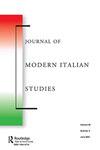流离失所后意大利的未来
IF 0.7
3区 历史学
Q1 HISTORY
引用次数: 0
摘要
意大利在过去和现在都有过多次流离失所的历史。这些可以说始于唐娜·加巴奇亚在2000年的同名书中描绘的意大利人的“许多流散者”,该书描绘了从中世纪到20世纪约2700万人从意大利移民的情况。这种向外的流离失所并不总是永久性的,并在意大利的叙事中产生了多种跨国认同网络。绝大多数发生在国家统一进程(1861–70)之后,也就是意大利第一次在非洲之角建立海外殖民地(1882–90)之前,从而在建国之初取代了国家的概念。二十世纪下半叶,流动性进一步急剧趋同,意大利移民减少,而从全球南欧和东欧向半岛的移民增加。这是在逐渐承认意大利(后)殖民历史的同时发生的,以及其后遗症在当代社会的众多结构和实践中仍然存在的方式。正如Cristina Lombardi Diop和Caterina Romeo所说:“将殖民、移民和移民联系在一起的时间和空间轴使意大利与其他欧洲环境不同”。作为编辑,我们的感觉是,在这些关于时间和空间位移、向外移民的过去和后殖民地移民的描述的巧妙融合中,可能会出现一些问题。在特雷莎·菲奥雷(Teresa Fiore)所说的意大利“被占领前的空间”的雄辩草图中,它们“在一个点上”连接在一起,这些空间将过去和现在的故事封装在新的跨国和后殖民网络中。但所涉及的时间弧线仅限于环顾四周,然后再回头——那么,我们在其中哪里可以找到关注未来的话语呢?如果我们将时间的目光向前转移,我们对意大利流离失所的理解会发生什么?我们能否开始构建一个工具包,让我们能够绘制、绘制、规划意大利流离失所后的未来,并为其腾出空间?过去和现在的流离失所可能如何困扰和扰乱这种未来?与此同时,意大利的多起流离失所事件都没有得到承认,而且往往隐藏在层层耻辱之中。内部运动杂志《现代意大利研究》2023,第28卷,第4期,403–414https://doi.org/10.1080/1354571X.2023.2198838本文章由计算机程序翻译,如有差异,请以英文原文为准。
Futures in post-displacement Italy
Italy holds multiple histories of displacement in both its past and present times. These might be said to begin with the ‘many diasporas’ of Italians sketched by Donna Gabaccia in her 2000 book of the same name, which charts the emigration of around 27 million people away from Italy from the Middle Ages to the twentieth century. Such outward displacements were not always permanent and gave rise to multiple webs of transnational identifications within narratives of Italianness. The vast majority occurred directly after the national process of Unification (1861–70), and just before the start of Italy’s first forays into establishing overseas colonies in the Horn of Africa (1882–90), thus displacing the concept of the nation at the very point of its foundation. There was a further, acute convergence of mobility that took place in the second half of the twentieth century, where Italian emigration shrank just as inward migration to the peninsula from the Global South and Eastern Europe increased. This occurred alongside a gradual acknowledgment of Italy’s (post-)colonial past and the ways in which its after-effects still persist within a multitude of structures and practices in contemporary society. As Cristina Lombardi-Diop and Caterina Romeo state: ‘the temporal and spatial axes that link colonization, emigration, and immigration set Italy apart from other European contexts’. Our sense as editors is that something might have gotten stuck in the neat convergence of these accounts of temporal and spatial displacements, of pasts of outward emigration and presents of post-colonial migration. They connect ‘all at one point’ in the eloquent sketch of what Teresa Fiore calls Italy’s ‘pre-occupied spaces’, spaces that encapsulate past and present stories within new transnational and postcolonial networks. But the temporal arc involved is limited to looking around, and then back – so where within it can we locate discourses that attend to the future? What would happen to our understandings of Italy’s displacements if we were to shift our temporal gaze forward? Could we start to put together a toolkit that would allow us to map, chart, plan for and make space for Italy’s post-displacement futures? How might past and present displacements potentially haunt and unsettle such futures? At the same time, multiple Italian displacements have passed unacknowledged, and have often been hidden in layers of shame. Internal movement JOURNAL OF MODERN ITALIAN STUDIES 2023, VOL. 28, NO. 4, 403–414 https://doi.org/10.1080/1354571X.2023.2198838
求助全文
通过发布文献求助,成功后即可免费获取论文全文。
去求助
来源期刊

Journal of Modern Italian Studies
Multiple-
CiteScore
1.00
自引率
25.00%
发文量
66
期刊介绍:
The Journal of Modern Italian Studies (JMIS) is the leading English language forum for debate and discussion on modern Italy. This peer-reviewed journal publishes five issues a year, each containing scholarly articles, book reviews and review essays relating to the political, economic, cultural, and social history of modern Italy from 1700 to the present. Many issues are thematically organized and the JMIS is especially committed to promoting the study of modern and contemporary Italy in international and comparative contexts. As well as specialists and researchers, the JMIS addresses teachers, educators and all those with an interest in contemporary Italy and its history.
 求助内容:
求助内容: 应助结果提醒方式:
应助结果提醒方式:


